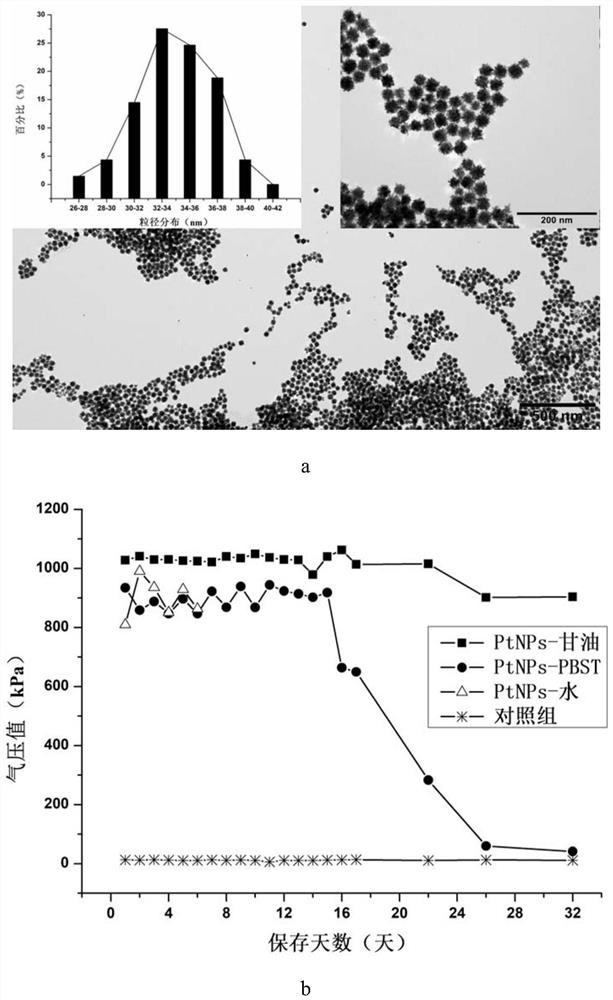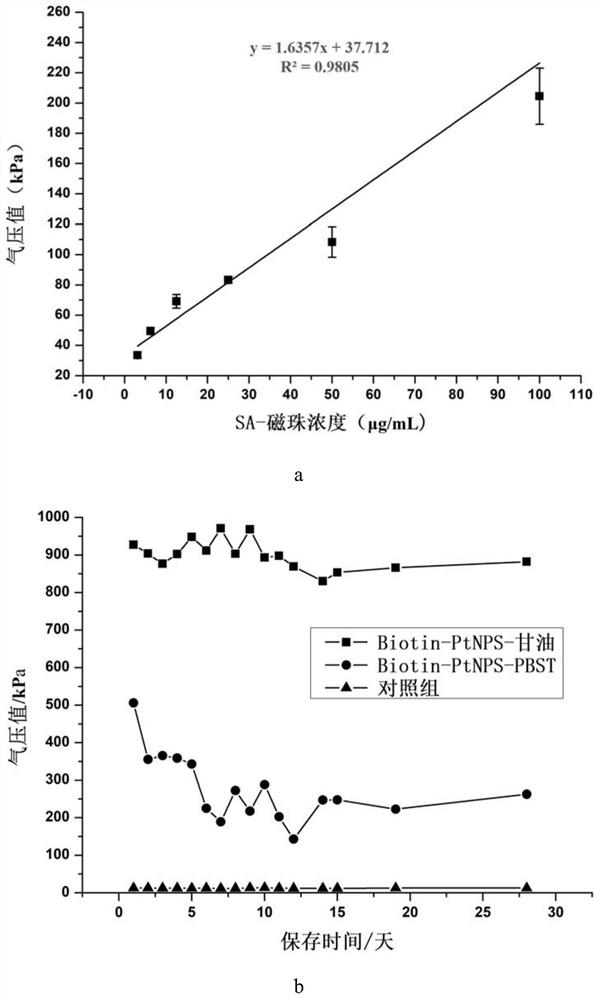A method of using glycerin to protect the catalytic activity of nano-platinum particles
A catalytic activity, nano-platinum technology, applied in the field of nano-platinum particles, can solve the problems of reducing the catalytic activity of nano-platinum, restricting nano-platinum, etc., and achieve the effect of good biocompatibility, good biocompatibility and wide application range
- Summary
- Abstract
- Description
- Claims
- Application Information
AI Technical Summary
Problems solved by technology
Method used
Image
Examples
Embodiment 1
[0027] Example 1: Synthesis of nano-platinum particles and stability study of the catalytic activity of nano-platinum particles resuspended in different solvents
[0028] Take a round bottom flask, soak it in aqua regia overnight and wash it with deionized water. Draw 45 mL of deionized water into the round bottom flask, and add 0.5 mL of 100 mmol / L chloroplatinic acid aqueous solution, stir and heat. After boiling, quickly add 5 mL of 0.4 mol / L ascorbic acid aqueous solution, and continue stirring. After the solution turns black, continue to heat and stir for 30 minutes to promote the stability of the platinum nanoparticles. Then, it was cooled to room temperature under stirring to obtain a nano-platinum particle solution, and the platinum element concentration in the nano-platinum particle solution was 1 mmol / L. Take 1 μL of nano-platinum particle solution, drop it on the supporting copper grid, and take the transmission electron microscope picture, the results are as foll...
Embodiment 2
[0030] Example 2: Protective effect of glycerol on the catalytic activity of surface-modified biotin nano-platinum particles
[0031] In order to further apply glycerol-protected platinum nanoparticles to the fields of biodetection and bioanalysis, it is necessary to modify functional molecules, such as biotin, on the surface of platinum nanoparticles. The steps to modify biotin are as follows:
[0032] Nano-platinum particles were newly synthesized according to the method in Example 1. Add 60 μL of 1% Tween 20 aqueous solution and 30 μL of 100 μmol / L mercapto-methoxypolyethylene glycol (mPEG-SH) to 6 mL of the newly synthesized nano-platinum particle solution, mix well and then add 120 μmol / L L of biotinylated mercaptopolyethylene glycol (biotin-PEG-SH) 60μL and 0.2mol / L phosphoric acid aqueous solution (H 3 PO 4 ) 300 μL, mix well and incubate at 37°C for 1 h. After incubation, centrifuge at 14,000 rpm for 5 min, remove the supernatant, and precipitate biotin-modified nano...
Embodiment 3
[0034] Embodiment 3: MTS method measures the cytotoxicity of the nano-platinum of glycerol protection
[0035] Taking human colorectal cancer cell SW480 as the model cell, MTS[3-(4,5-diethylthiazol-2-yl)-5-(3-carboxymethoxyphenyl)-2-(4-sulfophenyl)-2H-etrazolium,inner salt ] method to measure the viability of SW480 cells incubated with platinum nanoparticles protected by different solvents to test the cytotoxicity of platinum nanoparticles protected by glycerol.
[0036] Nano-platinum particles were newly synthesized according to the method in Example 1. Take 2 parts of the newly synthesized platinum nanoparticle solution, 50mL each, and centrifuge at 14000rpm for 5min to remove the supernatant. Glycerin, spare.
[0037] SW480 cells were digested and dispersed in DMEM medium (containing 10% fetal bovine serum, 1% double antibody), mixed gently and added to 96-well plates, 95 μL / well, and three groups of experiments were set up, respectively: control group, PtNPs- In the PBS...
PUM
| Property | Measurement | Unit |
|---|---|---|
| size | aaaaa | aaaaa |
Abstract
Description
Claims
Application Information
 Login to View More
Login to View More - R&D
- Intellectual Property
- Life Sciences
- Materials
- Tech Scout
- Unparalleled Data Quality
- Higher Quality Content
- 60% Fewer Hallucinations
Browse by: Latest US Patents, China's latest patents, Technical Efficacy Thesaurus, Application Domain, Technology Topic, Popular Technical Reports.
© 2025 PatSnap. All rights reserved.Legal|Privacy policy|Modern Slavery Act Transparency Statement|Sitemap|About US| Contact US: help@patsnap.com



